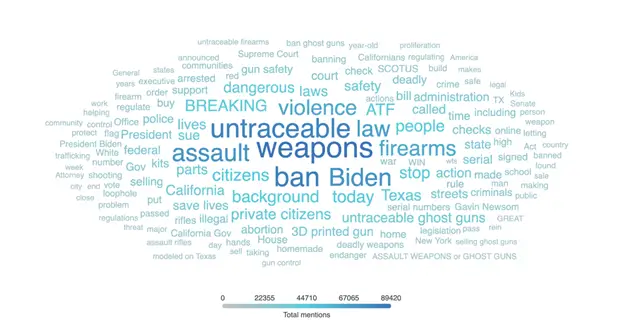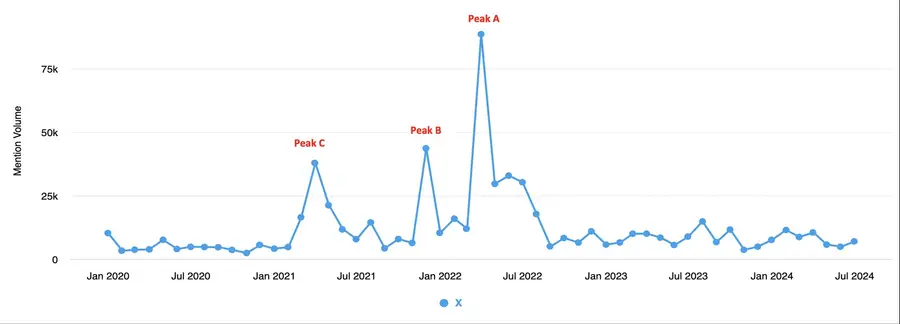This is the first in a series of four blog posts intended to educate the public and policymakers about online activity related to ghost guns in terms of marketing, sales, assembly, acquisition, communications, and intentions. Blogs 2, 3, and 4 dive deeper into these trends, why they matter, and how they can be used to inform policy and law enforcement solutions.
Every day in 2021, the latest year for which we have data, firearm homicides claimed an average of over 57 lives—a rate that was 37% higher than in 2019. A potential contributor to this increase is the influx of new or different types of firearms entering legal and illegal markets, including ghost guns (aka privately made firearms or PMFs). The number of ghost guns used in crimes and recovered by law enforcement soared from 1,629 in 2017 to 19,273 in 2021, a 1,083% increase. They were present in 700 homicides or attempted homicides. In North Carolina, where RTI International is headquartered, the number of ghost guns recovered by the Bureau of Alcohol, Tobacco, Firearms and Explosives (ATF) grew from 400 to 900 in 2022 alone.
Ghost guns are understandably a growing concern for law enforcement and the public. To address these concerns and provide more resources for policymakers as they grapple with this issue, RTI is currently conducting a series of analyses on issues and challenges related to ghost guns using data from social media posts.
What are ghost guns and why do people want them?
Ghost guns are unserialized firearms or firearm parts that are typically produced by manufacturers but assembled by individuals. Manufacturers must serialize full firearms before distributing them through federal firearm licensees (FFLs), and FFLs in turn must perform background checks through the National Instant Criminal Background Check System. These systems are bypassed by individuals making or assembling their own firearms (i.e., ghost guns) from parts which are purchased online or made using instructions posted online. Neither the online sales nor the resulting firearms are traceable, and in some cases the ghost guns are even made entirely of plastic, making them undetectable by magnetometers. These features allow individuals, some of whom are not allowed to legally purchase or possess firearms, to access ghost guns more easily, including juveniles, people with felony convictions or other firearm prohibitions, and members of domestic terrorist organizations hoping to avoid detection. Therefore, for people engaged in or planning to engage in crime, ghost guns offer some clear advantages over traditionally manufactured and purchased firearms.
Are ghost guns legal?
Sort of. On August 24, 2022, the ATF enacted a new rule that declared 80% “build kits”, and frame or receiver kits, as meeting the definition of a “firearm.” These kits supply purchasers with mostly complete firearms components, assembly instructions, and sometimes links to where they can purchase the complementary parts needed to construct a fully functional firearm in a short time. Under the new rule, 80% build kit manufacturers must be federally licensed, add serial numbers to their products, and conduct background checks on their purchasers. The rule further requires FFLs with ghost gun inventory to serialize those weapons, parts, and any other firearms, including 3D printed guns, that come into their inventory.
Beyond the ATF rule, 11 states and Washington, D.C. have enacted legislation regulating ghost guns, which range from statutes that predate but are similar to the 2022 ATF rule, to statutes that fully ban the possession of untraceable, unserialized guns for all persons. In September 2022, however, a federal judge issued a temporary injunction of the state level law in Delaware banning the manufacture and possession of ghost guns, and the ATF rule is similarly being challenged in court. Furthermore, ghost gun kit manufacturers quickly modified their products to circumvent the ATF rule (e.g., producing “76% build kits”) and continue sales. The U.S. Supreme Court is expected to issue a ruling on the updated ATF definition as soon as this December following oral arguments last month.
How do people access ghost guns?
Ghost guns are often purchased online in the form of “build kits” as described above. A recent investigation identified 80 online ghost gun build kit sellers, many of which began marketing the kits as early as 2015. Though ghost guns can also be constructed using other strategies—3D printers, computer-controlled milling machines, liquid resin casting kits—80% build kits (kits that contain 80% completed firearm frames and receivers) seem to have dominated the market.
What do we need to know to prevent ghost gun violence?
Because of data limitations, prior research on ghost guns is largely limited to studies describing the policy landscape. Despite the fact that it is increasingly common for ghost guns to be recovered from crime scenes, we still know almost nothing about who purchases and assembles ghost guns, what their motivations are, and how they acquire and use these weapons.
Leveraging Social Media Data to Explore the Issue and Challenges of Ghost Guns
To begin to address these gaps, RTI is self-funding research for our Center for Evidence-based Strategies to Reduce Firearm Violence to conduct a series of analyses using data from social media posts. Social media can be an important data source to understand emergent firearms behavior not captured by traditional surveillance systems, and can provide rich insights into the availability and features of products, industry and seller marketing efforts, and consumer characteristics, knowledge, and behavior.
For these analyses, RTI researchers focused on two popular social media platforms, X (formerly Twitter) and Reddit. Leveraging both platforms works well for research because both X and Reddit allow full access to all publicly available posts (often called the “firehose”). Furthermore, the two platforms offer complementary insights: X provides a broader perspective on the dissemination of information, whereas Reddit enables a more in-depth analysis of consumer behavior through its engaged and specialized communities. As of 2023, an estimated 42% of US adults aged 18 to 29 years use X/Twitter and 44% of US adults aged 18 to 29 years use Reddit.
RTI used Brandwatch, a commercially available listening platform that provides historical data from social media platforms to rapidly surveil all publicly available conversations using keyword queries. Brandwatch uses natural language processing tools that extract top keywords, phrases, topics, authors, and top shared posts in near real-time to help identify potential signals in the data. Within the tool, we developed a search query on ghost guns to gather data from X and Reddit posts. For this blog, we have concentrated on social media discussions on X to assess the relevance of ghost guns as a topic and to identify emerging trends on the platform. From January 2020–July 2024, we collected approximately 659,000 posts from 273,000 unique authors. Brandwatch detected three trending topics in the discussion: the Supreme Court, selling ghost guns, and banning assault weapons.
The word cloud in Figure 1 depicts the most frequently used terms in conversations on X about ghost guns and highlights several important trends. The conversation is heavily focused on law and regulation issues (e.g., ban, regulation, sue, SCOTUS), public safety (e.g., violence, safety, dangerous) and political figures, especially President Biden. The high frequency of terms related to bans, violence prevention, and legislation underscores the current push for stricter controls on these weapons. These data reflect a significant public discourse that links ghost guns to broader debates about gun control, safety, and the effectiveness of both federal and state regulations. Interestingly, the term “abortion” appears frequently in X posts on this topic, likely reflecting that gun control debates may occasionally intersect with other highly politicized issues. Finally, discussions on ghost guns are also framed in the context of public safety and mention terms like “mass” and “school,” which are likely tied to school shootings and other high-profile violent events.

Figure 1. The most frequently mentioned 150 Terms on X about ghost guns between January 2020 and July 2024.
Figure 2 is a Volume over Time graphic from X for the same period (January 2020–July 2024) and shows three key moments when conversations surged about ghost guns.

Figure 2. Ghost gun-related post volume from X between January 2020 and July 2024.
- Peak A: April 11, 2022. President Biden announces new firearm regulations targeting ghost guns by imposing restrictions on the manufacturing and sale of untraceable firearms.
- Peak B: December 20, 2021. California Governor Gavin Newsom proposes a new law that aims to allow private citizens to sue individuals involved in the production or sale of assault weapons and ghost guns.
- Peak C: April 7, 2021. The White House announces initiatives to combat gun violence, including measures to stop ghost gun proliferation, regulate modified pistols, and support the implementation of red flag laws and community violence interventions.
The observed trends indicate that ghost guns, previously limited to niche discussions of a specialized hobby, have now entered mainstream (social) media and emerged as a robust topic online.
Read blogs 2, 3, and 4 to delve deeper into the topic of ghost guns online.
